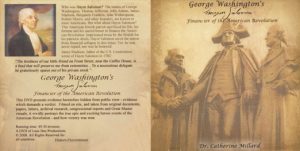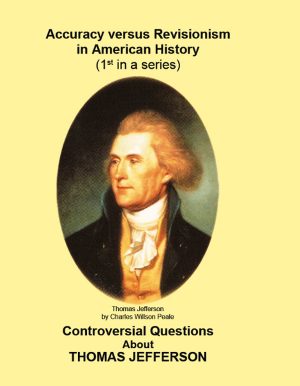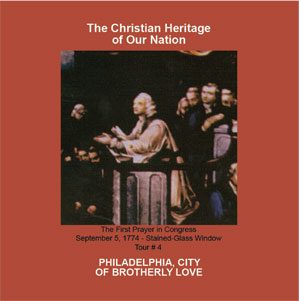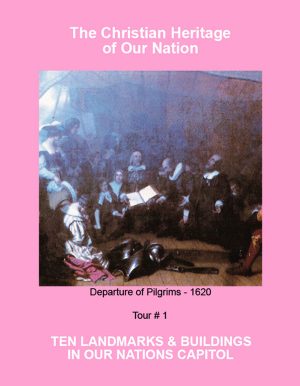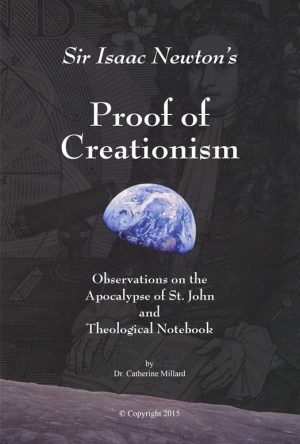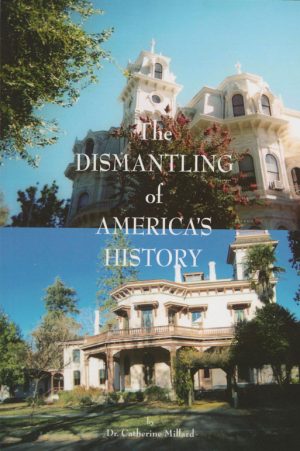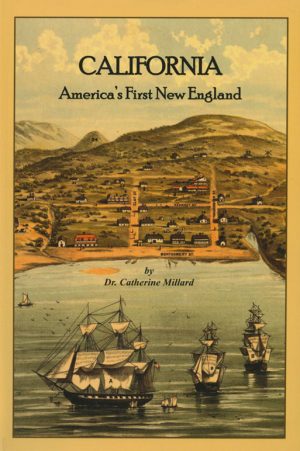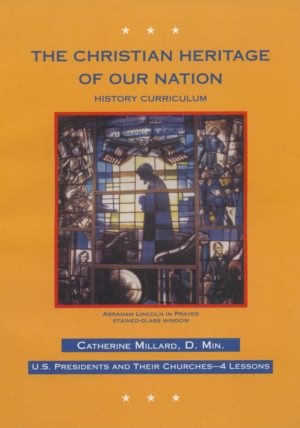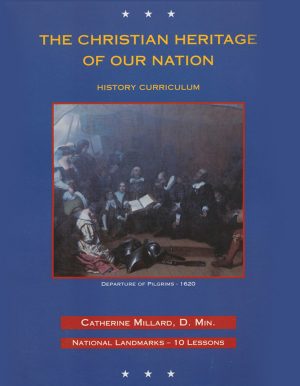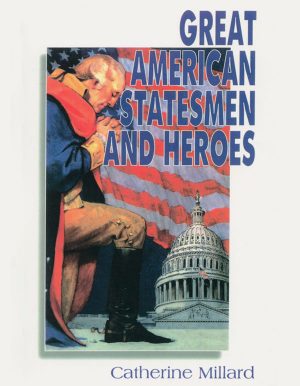Fifty years of God’s peace and prosperity elapsed over Pennsylvania after William Penn’s 170l Charter of Privileges to his colonists. In 1751, the Year of Jubilee, the Pennsylvania Assembly ordered a commemorative bell to be cast in England, for the anniversary of Penn’s Charter. This is the bell now known as the famed Liberty Bell. Speaker of the Assembly, Isaac Norris, himself a Quaker, chose a portion of Leviticus 25:10 for inscription upon the bell: “…proclaim liberty throughout the land unto all the inhabitants thereof…”
It was in the steeple tower of Independence Hall that the fyamed old bell was rung to proclaim American Independence. This symbol of American freedom and democracy rang for all the major landmarks of our nation’s history, until in 1835, while tolling the requiem for Chief Justice Marshall, it cracked. In 1873, the bell was lowered to a spot directly below the tower. The full verse from Leviticus 25:10 was then inscribed upon its base: “And ye shall hallow the 50th year and proclaim liberty throughout the land unto all the inhabitants thereof .” For years the Liberty Bell was housed in Independence Hall where it had originally hung, but at midnight, on the first of January, 1976, despite great protest by patriotic and tradition-loving Philadelphia, the famed old bell was moved from Independence Hall to an ultra-modern structure across the street. It is unfortunate that the historic base of the Liberty Bell, which included the full verse from Leviticus 25:10 is no longer on display. This foremost symbol of American Independence is now interpreted by the Independence National Historic Park overseers as “a symbol of world freedom” – rather than what its true Christian history indisputably proclaims: “Thou shalt hallow the 50th year and proclaim liberty throughout the land unto all the inhabitants thereof.”
The pastor of one of the oldest and most historic churches in Philadelphia told me that the Independence National Historic Park authorities had convened a meeting of the heads of all historic landmarks and shrines to discuss the removal of the Liberty Bell from Independence Hall. In his own words:
We had our backs against the wall when they told us that they expected 30 million visitors for the bicentennial of the Declaration of Independence in 1976. We were terrified at the thought of so many people visiting Independence Hall during that year. Therefore, we had no option but to acquiesce to their demands. The only problem was that they made a monumental error of quoting an estimated 30 million, when only three million arrived. By this time, however, the Liberty Bell had already been moved out of its national historic setting since it rang out America’s independence from Great Britain in 1776.
The following interview with Henry M. Shuttleworth, National Park Ranger, and Chief Bellringer at Independence Hall for the past 30-35 years, was recorded by me in November, 1986:
Ranger:
I would like to see the Liberty Bell back in Independence Hall. |
Author:
Why is that? |
Ranger:
Well, that is where it all took place. |
Author:
What do you mean, “it all took place?” |
Ranger:
That’s where the bell tolled when the Declaration of Independence was celebrated, when our Constitution was celebrated, when the Articles of Confederation were signed. |
Author:
And many other great landmarks of America’s history. |
Ranger:
That’s the original spot. Where it is today, is not. |
Author:
It resembles a railroad station. |
Ranger:
You are talking to Henry Shuttleworth, the Head Bellringer of Independence Hall. That’s why I feel I know a little bit about our bells. Our bells is my hobby, and I am just reading now about Christmas in the Revolutionary period. That’s how I start my New Year’s Eve – by tolling the bells for 13 bell rings for the 13 colonies. The Centennial Bell weighs 13,000 pounds. A thousand pounds for each state. It is in Independence Hall. It was given us by Queen Elizabeth to help us celebrate our 200th Anniversary. |
Author:
It is very interesting that it should be put up in 1976 here at the Independence National Historic Park, Department of the Interior new Visitors’ Center, the very year of the Bicentennial of the Declaration of Independence, and that at that time, the Liberty Bell, which tolled in Independence Hall to announce this great event, was moved to the “Pavilion,” a squat building across the road; and that this bell (the Bicentennial Bell) here, is now called: “The Freedom Bell.” |
Ranger:
The Bicentennial Bell, the Queen’s Bell, some people refer to it as the Freedom Bell, but they also refer to the Liberty Bell as the Freedom Bell. So I’m a little bit cautious myself, in saying the Freedom Bell. The Liberty Bell is representative of freedom as Americans, would you not say?The Liberty Bell is representative of freedom as Americans, would you not say?The Liberty Bell is representative of freedom as Americans, would you not say?The Liberty Bell is representative of freedom as Americans, would you not say? |
Author:
The Liberty Bell is representative of freedom as Americans, would you not say? |
Ranger:
That, and the Statue of Liberty. There’s nothing greater than those two as symbols of freedom for this country. |
Author:
Yet the Department of Interior has removed it from Independence Hall, where it belongs! |
|
At another interview, this time with Barbara Applebaum, National Park Service Ranger/Lecturer on December 8, 1986, I recorded the following: |
Ranger:
The Liberty Bell basically just started to wear out in the 1830’s after 80 years of use, and it wasn’t really that great bell to begin with, so they really didn’t notice that it didn’t sound too good for a while….If it hadn’t been called the “Liberty Bell” by the abolitionists, it would have probably been just used as scrap metal, and just been thrown out. It was just an ordinary bell that rang up to the 1840’s and there was no significance. The significance developed after the American Civil War because the nation really needed to be healed after the Civil War, because the North and the South really weren’t on speaking terms. And the bell became this big romantic symbol of liberty for everybody and brotherhood; and by World War I it had expanded not just for liberty in the United States, but liberty to people all over the world. It was only at the time of the Civil War that this bell got its significance. In the 1850’s, say 1830’s it started to become significant to the Abolitionists. In the 1850’s it expanded, and after the Civil War it became this big romantic symbol that it is today. |
Author:
And before that – what was the reason it was there? |
Ranger:
They needed a large, loud bell to communicate back in the 1770’s. Philadelphia had grown so large that they needed a large bell to let people know the news. The news of the day, the time of day, funerals, fires. |
Author:
And it wasn’t used for any other significance at all until the Civil War? |
Ranger:
Well – it rang on July 8 for the first Public reading of the Declaration of Independence, but every bell in town rang for that; and it rang when George III was crowned King of England, but every bell in town rang for that. So the real significance is after the 1830’s. |
The above commentary given by an Independence National Historic Park Service, Department of the Interior Ranger, represents falsified, rewritten, American history, in keeping with the removal of the Liberty bell from Independence Hall. The Liberty Bell’s unsurpassed symbolic and historic fame – in short the very reason for her tremendous significance to all Americans, is that she rang out all the major landmarks of America’s birth. The Liberty Bell also tolled the requiem for some of the nation’s greatest founding period heroes, such as Thomas Jefferson, John Adams and fourth Chief Justice, John Marshall. It is thus a tragic and serious “crime against Americans” to have the Liberty Bell’s proud heroic associations removed; her history being now equated with “any Bell in town” by the curators of Independence National Historic Park, overseers of the nation’s most historic square mile. This discloses that the park rangers have been indoctrinated to leave out the crucial Christian events for which this foremost symbol of America’s history and Independence rang (or tolled) – from 1776 to 1830! What a travesty for an entire nation’s historic legacy.
The Liberty Bell has now been placed in the Independence National Historic Park, Department of the Interior Urban Renewal Tour literature. All that is said about this famed symbol of America’s liberties and freedoms reads as follows:
…On the first block directly across the street from Independence Hall is the Liberty Bell Pavilion, the new permanent home of the Liberty Bell, moved there on January 1, 1976. The center block includes the Judge Edwin O. Lewis Quadrangle where special events and entertainments are accommodated throughout the year….
In a wonderful old history book on the restoration of Independence Hall, the Committee on its restoration and return to original significance gives an accurate account of the value and meaning of this bell:
The old “Liberty Bell,” which had been taken from the cupola and placed within the chamber, we removed to the vestibule, suspending it from the original beam and scaffolding. (The latter having been discovered nearly intact in the steeple). We deemed it appropriate to inscribe upon its base the whole Scriptural text, a part of which had been moulded upon the bell in 1753, as it, even then, so essentially predicted and ordained: first, “Liberty throughout the land,” and secondly, the CENTENNIAL celebration thereof. The whole has been enclosed by a plain railing, which circumstances show to be essential to its preservation.
The two workmen who cast the bell at White Chapel Foundry in England were “Pass” from the Island of Malta, and “Stow,” a son of Charles Stow, the door-keeper of the Council. After being hung up in its place, it was found to contain too much copper, and Pass and Stow “were so teased with witticisms of the town” that they asked permission to cast it over again. For their work, Pass and Stow were paid 60 English pounds, 13 shillings and five pence.
The Liberty Bell is now housed in a modern, squat structure bearing the name “The Pavilion,” being the identical new name given to the famous Old Post Office Building in the nation’s capital (site of the first Flag Day celebrations), after its renovations in 1982. Although expatriated from its original setting where it rang out all the greatest landmarks of our founding period, the Liberty Bell continues to maintain its place in the hearts of Americans as a unique symbol of the United States Declaration of Independence from British colonial rule:
…Proclaim liberty throughout the land unto all the inhabitants thereof (Leviticus 25:10).
The Liberty Bell has now been moved in 2001 to a recently-built modern structure with a 21st century, industrial-looking steel façade, diametrically facing historic Independence Hall, a masterpiece of colonial splendor, and quite the opposite to its new site. My discussion today with a director of the Independence National Historic Park, Department of the Interior, disclosed that upon entering the building, the visitor is met with approximately 10 exhibits preceding the famed old Liberty Bell. 3-4 of these exhibits major upon the Abolitionists/Slavery, while others major upon the historical tie of the Native Americans to the Liberty Bell.
To recapitulate the history and significance of the Liberty Bell: It was in the steeple tower of Independence Hall that the famed old bell was rung to proclaim American Independence. This symbol of American freedom and democracy rang for all the major landmarks of the nation’s founding history, until in 1835…it cracked.
To learn more, click here.
_______________________
Bibliography:
1
Committee on the Restoration of Independence Hall, Mayor’s Office. Report. Philadelphia, June 12, 1873, pp. 2, 3. Library of Congress, Rare Book Collection.
2
Ibid.

